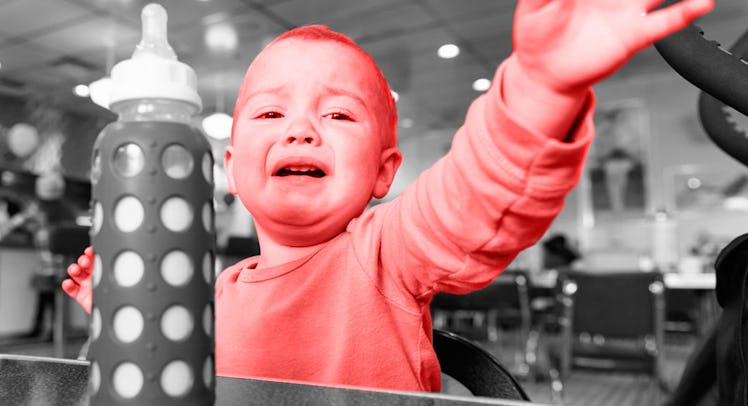How to Handle Whining, Tantrums, and Other Annoying Kid Behaviors
Is your kid whining, not sharing, or throwing a tantrum? Take a deep breath and teach them how to be less, well, annoying.

Whining, temper tantrums, ignoring adults – we all did these things when we were kids, and we now have to deal with them as parents. As it turns out, some ways of handling annoying kid behaviors are better than others. In general, we should view the behavior as an opportunity. “If we’re doing it right, discipline is teaching,” says Donna M. Volpitta, Ed.D, founder of The Center for Resilient Leadership. “It’s not punitive.” Here’s how Volpitta would handle five common kid behaviors, turning annoyances into life lessons that hopefully raise a more resilient child.
Whining
Whining is a strategy that kids use because it works. Start by telling them that whining isn’t going to work anymore, and — here’s the hard part — stick to it. That means not giving them what they want when they whine for it. Say something like “Because you whined, it’s an automatic no.” But don’t stop there, coach them on a better strategy to get what they want: “Try asking in your regular voice next time.” Of course, using their regular voice doesn’t guarantee that your kids will always get what they want, but Volpitta says that if you stay consistent, they’ll learn fast that whining equals “no.”
ALSO: Effective Discipline Strategies for a Child With ADHD
Not Sharing
Why don’t kids share? Usually because they don’t know how. Take this situation: Your kid sees another kid playing with a very desirable toy. She toddles over and tries to take toy. The other kid holds on tight. Crying ensues on both sides. Volpitta says to teach the child who wants the toy to ask first, “Can I have a turn?” The other child will mostly likely say no, because she thinks her only option is giving up the toy now. Tell the other child that she’s probably not going to use that toy forever, so instead adults can coach her to say, “I’ll give it to you when I’m done.” Most of the time, according to Volpitta, the child with the toy hands it over within two minutes. It’s called “scripting,” and the result is that each kid now has a verbal strategy for getting (or holding onto) the desired object.
Throwing a Temper Tantrum
From toddler to teen, a kid throwing a tantrum is no longer in his rational mind. “They’re in the limbic system of their brain, and the more parents try to work with them logically while they’re in that part of the brain, the more frustrating it’s going to become,” says Volpitta. Instead, do some pre-work by creating a trigger script for when that situation happens. In Volpitta’s family, it was “stairs,” which meant that the person tantrumming, or about to tantrum, needed to go to one of the staircases in the home, away from other family members to avoid saying things they’d regret. Once calm, the person can come back to talk about their feelings. This applies to mom and dad too (losing your temper is something that happens to everyone). For toddlers, this strategy is too advanced. Simply reaffirm that they can’t have or do what they want, and that if they keep screaming they will have to go in the other room. If they keep screaming, take them to the other room until they calm down. Remember not to try and engage rationally with them, or to get spun up yourself over it. Really, there’s not much you need to do other than staying calm and letting them ride it out.
MORE: The Biggest Lies Parents Tell Themselves About Discipline
Ignoring Mom and Dad
Kids ignore the call to dinner or to go brush their teeth because they don’t want to stop whatever it is they’re doing. Teach them that a better strategy is to answer: “I’m in the last stage of the game, can I have five more minutes?” Volpitta says that until taught otherwise, kids seem to think that the only option is to stop what they’re doing and come down to eat right away, or to ignore mom and dad so they continue doing what they’re doing. Give your kid a better strategy: communication.
Not Picking Up After Themselves
Whether we’re talking about putting away toys or clothes or dinner plates, Volpitta says to create a structure so that your daughter doing what you want her to do logically leads to something that she wants to do. This is, after all, how it works in real life for adults. We don’t always want to do something, i.e. cook dinner, but we want to eat, so we cook. If the family is going to Grandma’s house that afternoon, remind your daughter that her toys need be picked up first. If she wants to play video games after dinner, she must first take her plate to the sink. If she doesn’t do what you’ve asked of her, she doesn’t get to go to Grandma’s house, or play video games. And you have to be a stickler on this one. Even when it’s inconvenient for you. “This one’s all about the follow-through,” says Volpitta.
Read more of Fatherly’s stories on discipline, punishment, and behavior.
This article was originally published on